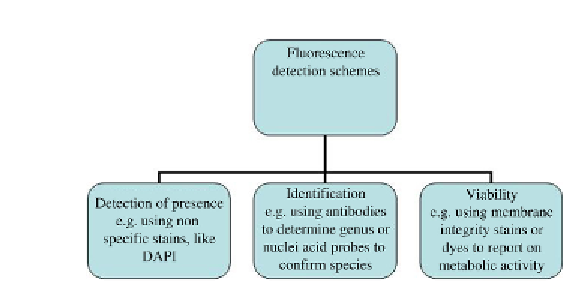Biology Reference
In-Depth Information
Figure 5.2
Overview of fluorescent approaches to determining information about
microorganisms. (For color version of this figure, the reader is referred to the online ver-
sion of this topic.)
detection of microorganisms or for an indication of viability. For
Cryptospo-
ridium
, DAPI is utilized to stain the nuclei in the sporozoites thus enabling
confirmation of sporozoite presence, and therefore that the oocyst is unex-
cysted.
Finally, fluorescent stains can be employed to indicate viability, using
for example propidium iodide (PI) or fluorescein diacetate (FDA). PI is
membrane-impermeable and therefore exclusion from a cell suggests that
the membrane is intact. FDA is membrane-permeable and is cleaved by
enzymes in the cell to generate a fluorescent product, which is membrane-
impermeable. FDA therefore indicates both intracellular activity and mem-
brane integrity. Further examples are given in Ref.
2
.
An alternative means to detect viability is a fluorescent means of mea-
suring enzyme redox activity. This was applied to protozoa in 2001 using
5-cyano-2,3-ditoyl tetrazolium chloride to determine the redox activity
potential of the respiratory electron transport system as an indicator of via-
bility.
3
Waterborne Inc. was involved in the study, but the findings do not
yet seem to have translated into a commercial product.
There has been much development in super-resolution imaging to iden-
tify smaller structures, in ways to image live cells and also in fluorophore
development, all of which are beyond the scope of this topic. We recom-
mend consulting certain review articles for more information.
4-7
Some
aspects of improved fluorophores are covered in Chapter 9, particularly
quantum dots.
The use of fluorescence as a means of detection requires the availability
of suitable probes. Fluorescence methods are being developed for emerg-
ing zoonotic pathogens such as leptospira.
8
Direct fluorescence analysis is

Search WWH ::

Custom Search